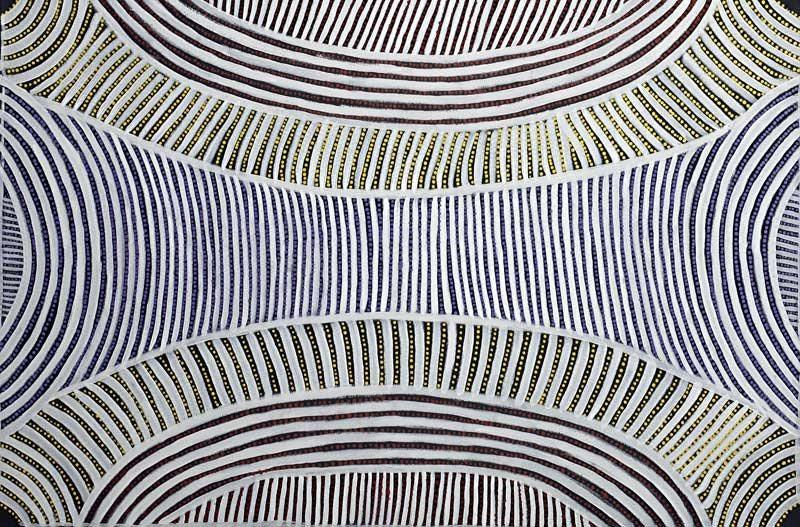POA
Enquire
Couldn't load pickup availability

Ada Bird Petyarre
/ Awelye - Women's Ceremony
/ Cat.No: 9457
The painting is titled Awelye and was done by Ada in 2003. Ada who resided in Utopia, ca 250 km north/east of Alice Springs in the Northern Territory of Australia visited her family in Alice Springs at the time when I visited her family of artists. Whilst there she did this painting for me which is now a rare item in our collection.
Ada Bird Petyarre c. 1930 - 2009
Ada Bird Petyarre was the eldest of the seven, famous, Petyarre sisters from Utopia. They are Gloria (QV), Nancy, Myrtle, Kathleen, Violet, and Jeanie Petyarre. Lindsay Bird (QV) is her brother-in-law. She passed away peacefully on June 28th 2009
In some sense she was also the most ‘traditional’ of the sisters with her early works particularly coming directly and purely out of women’s body paint designs. Importantly, such markings ‘call up’ from the past the power of creation ancestors, temporarily transforming the state of the wearer. Such is the power of the designs and the accompanying knowledge.
She had begun, like most of the other major Utopia painters of her generation, with batik in the movement described earlier in this book. She was there at the very first workshop and went on to make some outstanding pieces. Her batiks are held in major collections in Australia and overseas.
When painting began at Utopia Ada was once more right there at the beginning. Indeed she had built a reputation through batik and was immediately accepted as a painter on canvas. Her cultural significance was secure. Very early (1989) in her painting career a major work of hers was acquired by the National Gallery of Australia. Collectors sat up and took notice.
Born around 1930 on Utopia Station at Atnangkere, Ada lived the last part of her life at Mulga Bore. Her country was Atangkere and she is an Anmatyerre/Alyawarre speaker. Many of her paintings are based on womens’ s body paint and incorporate notions of bush medicine, the bush bean, the Emu, Pencil Yams and grass seeds (Ntange). However, she also shares with her six sisters the Thorny Mountain Devil Lizard (Arnkerrthe) Dreaming.
During 1977, Ada participated in the batik program at Utopia and therefore was one of the originators of the “Utopia School”. It has been shown that the batik makers moved on to painting with acrylic paint and canvas in 1988 and Ada was also deeply involved with this activity, her work being seen in the ”A Summer Project” show organised by CAAMA. The project, a resounding success, led to an exhibition in Sydney at the S. H. Ervin Gallery. Owner of the Utopia gallery recalled,
This was but the beginning, for the explosion of painting was remarkable, so much so that noted authorities were consistently confounded with the rapid development as individual artists began producing works of great sophistication.
This project saw the public beginning of Ada’s painting career. She showed two works in the Sydney exhibition, ”Ceremony for Endunga: Sacred Grass” (#2a) and “Endunga: Sacred Grass Awelye (#2b)”.
Two years later she had her first solo show, at Utopia Art in Sydney, a remarkable achievement for a ‘new’ painter. Although Ada would tell you that she had been ‘painting’ all her life. Then, by 1995, it was said of Ada that she was ‘the second most important artist from Utopia (after the prodigious Emily Kngwarreye)
Her work was based solidly in symbols and the power and depth of meaning that they convey. This, of course, is the basis of desert art and Ada is rightly recognised as one of the founders. As is the case with a number of other old ladies of the desert her paintings demonstrate one of the last remaining links with women’s ceremonial knowledge.
Quite apart from her painting life that was demanding enough, Ada had six children to her husband before he passed away. Her children are June, Hilda, Colin, Steven, Paddy and Ronnie. Like so many other painters from Utopia, Ada’s works are now collected throughout the world and reside in outstanding collections such as, Robert Holmes a Court, Perth; National Gallery of Australia; Art Gallery of New South Wales, Sydney; Richard Kelton Foundation, Santa Monica, California; and the University of Queensland, Brisbane

